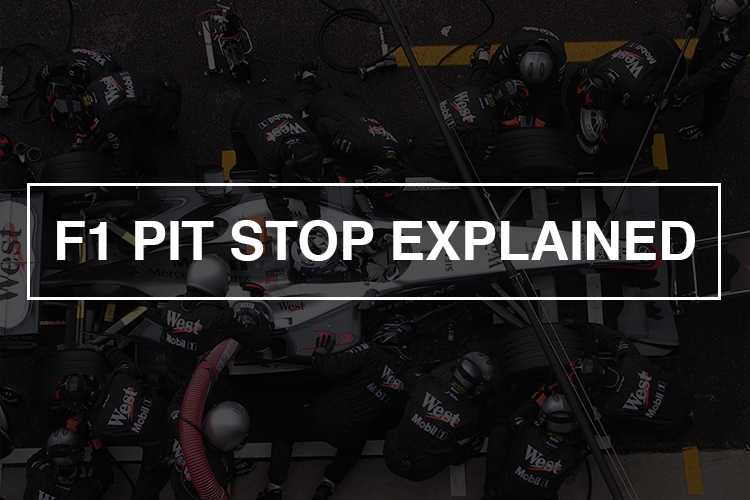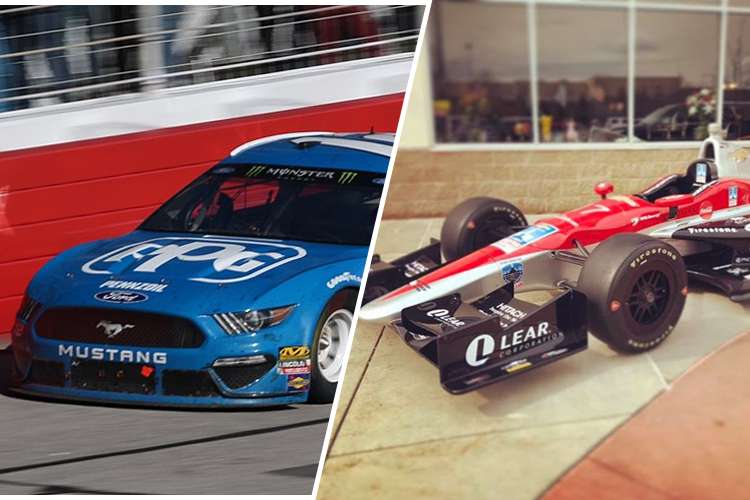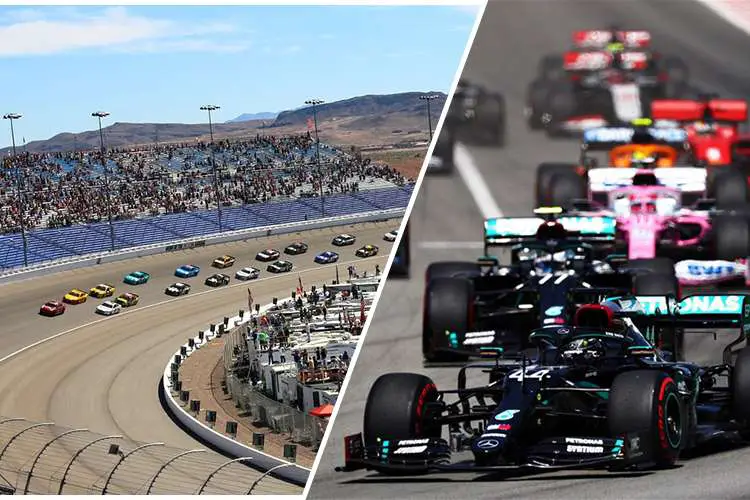Last Updated on August 29, 2023 by Pittalks
Did you know that the first NASCAR race was held in 1949, while the first Formula One (F1) race wasn’t until 1950?
Nowadays, F1 races are typically watched by fans all over the world, while NASCAR races are popular only in certain regions of the United States. So why is F1 so much more popular than NASCAR?
Let’s take a look at some of the differences between these two types of racing.
The races
NASCAR races are held on oval tracks; while F1 races are held on road courses
There are 3 main types of tracks used in NASCAR:
- Short tracks (less than 1 mile/1 lap – Bristol, Martinsville, Richmond)
- Intermediate (Atlanta, Charlotte, etc.)
- Superspeedway (Daytona, Pocono)
While many people think NASCAR is just cars “turning left for a living”, there are several tracks that involve both directions. However, the oval tracks are still the most common.
Formula 1 cars can turn in either direction, that’s one of many reasons why F1 fans love the sport. The F1 races are much more challenging because the tracks include many twists and turns.
NASCAR races last for about three to four hours; F1 races last for about an hour and a half
This is because of 3 reasons:
- NASCAR races are much longer. For example, Daytona 500 is 500 miles long, while Monaco Grand Prix is only about 161 miles.
- The cars are also much slower in NASCAR. The average top speed of a NASCAR race is over 200 mph; the average top speed of an F1 car is about 220 mph.
- NASCAR cars run many warm-up laps and have more accidents. Therefore, they have more yellow flags than F1 does.
Because NASCAR races are way longer, they are split into 3 stages. F1 doesn’t have that.
NASCAR is about the best strategy; F1 is about the fastest car
It doesn’t mean that NASCAR doesn’t require speed and F1 doesn’t require strategy.
It’s just that in NASCAR, with the best strategy, little to no mistakes, and a little bit of luck will make you win the race. If you have the fastest car in a NASCAR race, but you are not patient, you do not try hard enough to avoid accidents, or your pit crew make a little mistake, you will not win.
In F1, the fastest car will almost always win the race. This is because tracks are so twisty that it’s hard for cars behind to catch up (because of “dirty air” left by front cars, cars behind will lose downforce and grip). This makes overtaking by the speed in F1 very difficult, so the best way to do this is to use pit stops. However, F1 races have fewer pit stops (from 2 to 3) than NASCAR do (from 4 to 12.)
NASCAR races have 40 cars; F1 races have 20
As mentioned above, NASCAR races have lots of crashes. During a typical accident, there can be a dozen of damaged cars that are not able to continue the race. Therefore, the number 40 will eventually reduce when the race goes on.
NASCAR’s pit stop takes 14s; F1’s takes 2.5s
F1 pit stops are much faster not because the NASCAR pit crew are less professional. There are many reasons for this huge gap:
- NASCAR pit crew only includes 5 people, while F1’s have more than 20.
- There are 5 lug nuts in a NASCAR’s wheel and only 1 in an F1’s.
- Refueling is not allowed in F1 pit stops, while NASCAR cars need to be refueled as the race is much longer in length.
NASCAR races have much more crashes
Both of the sports do not allow drivers to hit each other intentionally. However, in NASCAR there are more chances that this could happen because of the number of cars on track (actually you can see accidents on every single NASCAR race).
The crashes are, in fact, what makes NASCAR an interesting sport. So, drivers hit each other, causing chaos on the track, not really a big deal and they rarely get any penalty for that.
On the other hand, in F1, if you hit another car on purpose, you will have a serious penalty. This is because an F1 crash can cost up to millions of dollars and the crash itself can be extremely dangerous for the drivers. The video below is a good demonstration of how severe an F1 crash can be.
The car design
NASCAR cars have V8 engines; F1 cars have V6 engines
NASCAR cars use a 90° 5.86-liter V8 engine, which can produce up to 750 HP. This number is technically equal to an F1 engine (turbocharged 90° 1.6-liter V6). However, since 2014, F1 engines use an energy recovery system (ERS) to gain some extra HP, so theoretically, F1 engines can achieve more than 1000HP.
The fact that NASCAR engines do not use any turbochargers or superchargers but still have the magical number of HP is something that still amazes many people.
Moreover, NASCAR engines are designed to last much longer than F1’s.
NASCAR cars’ average top speed is around 200 mph; F1 cars’ is 220 mph
A powerful engine is not the factor that affects the speed. F1 is much faster because of 3 main reasons:
- More powerful engine (as mentioned above)
- Better aerodynamics, more downforce. Therefore, NASCAR cars do not have the same level of grip as F1 cars do (the better the grip, the faster you can take corners)
- NASCAR cars weigh 3400 lbs; F1 cars weigh 1300 lbs. NASCAR cars are bigger and bulkier with the sedan chassis while F1 cars have open wheels and cockpit.
NASCAR cars cost around $400,000; F1 cars cost more than $12 million
According to fingerlakes1.com, the cost of a NASCAR car can be broken down as below:
- Engine: $60,000 – $150,000
- Chassis: $70,000 – $120,000
- Insurance: $30,000 – $50,000
- Tires: $350 – $450/1 tire
F1 cars are just on another level. According to chaseyoursport.com, an F1 car can cost up to $12.20 million:
- Engine Unit: $10.5 million
- Chassis: $650,000 – $700,000
- Gearbox: $400,000
- Hydraulics: $170,000
- Front wing: $150,000
- Fuel Tank: $140,000
- Rear wing: $85,000
- Steering wheel: $50,000
- Halo: $17,000
- Set of tires: $2,700
Related article: Are NASCAR cars manual?
The drivers
NASCAR drivers are older
The average age of NASCAR drivers is 39 while F1’s is 25.
The biggest problem drivers must encounter when they accelerate, brake, or take corners is G-force. A healthy human body can withstand 9 Gs for a few seconds. As drivers age, their neck and back are less able to cope with the G-force stress.
NASCAR drivers typically take a maximum of 3 Gs during the curve, while F1 drivers experience 5 Gs while braking, 2 Gs while accelerating, and 4 to 6 Gs while cornering.
Most of NASCAR drivers are American; F1 drivers are from all over the world
Because NASCAR is the motorsport that is mainly popular in the US, most of NASCAR drivers are American. Bleacherreport.com said “Although NASCAR has focused on adding more marquee international drivers to the Sprint Cup Series in recent years, the results have been average at best. Attempting to find foreign names on the NASCAR all-time wins list is like trying to find a needle in a haystack.”
On the other hand, F1 is very common all over the world. Therefore, their drivers are from different continents, having different colors.
You may also like: Are F1 cars manual? If so, how many gears do they have?
Can F1 beat NASCAR?
If we’re talking about cars, definitely yes! F1 cars have more powerful turbocharged engines and a lot more downforce. Therefore, F1 is faster than NASCAR both on the straight line and corners. Let’s take a look at the video below so you can have an idea of how insane this gap is.
And that are the differences between F1 and NASCAR. Sports of all kinds, from F1 to NASCAR or rally racing, are all exciting in their own ways. We should set aside the differences and just enjoy them for what they are.
Other references:
- https://www.popularmechanics.com/cars/a6652/5-ways-nascar-stock-engines-arent-actually-stock/
- https://auto.howstuffworks.com/auto-racing/nascar/nascar-basics/nascar4.htm
- https://us.motorsport.com/general/news/average-driver-age-differs-in-auto-racing-series-across-the-world/1804838/
- https://www.carsforsale.com/pop-culture/think-you-could-drive-in-nascar/
- http://www.formula1-dictionary.net/g_force.html
Related articles
-

F1 pit stops 101 | All rules simply explained
Did you know that the average F1 pit stop takes just under three seconds?
In that time, 4 tires are changed, and any necessary adjustments are made. In a sport where fractions of a second can make….Read more
-

NASCAR vs. IndyCar – Differences from A to Z
Did you know that the fastest speed hit by a NASCAR vehicle was recorded at 199mph, while IndyCar are known to reach 236mph?
The longest NASCAR track is the Talladega…Read more

It’s not as easy as it sounds, though, as drivers are often battling G-forces that can reach up to 3Gs. For example, if a driver weighs 200 pounds, they would feel like they’re carrying 600 pounds on their body. So while racing and having to relieve yourself may not be the easiest thing in the world…. Read more


I’ve been exploring terpene-based products live terpenes recently, and I’m indeed enjoying the experience. The scents are with, natural, and pleasant. They annex a nice drink to my day after day programmed, ration congeal the mood and atmosphere. A massive track down for anyone who appreciates savoury wellness tools.